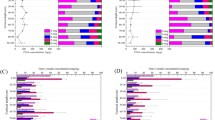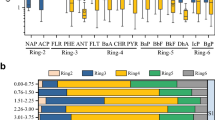Abstract
The heavy metal and polycyclic aromatic hydrocarbons (PAHs) contents were evaluated in surface soil and plant samples of 18 wild species collected from 3 typical industrial sites in South Central China. The accumulative characteristics of the plant species for both heavy metal and PAHs were discussed. The simultaneous accumulation of heavy metal and PAHs in plant and soil was observed at all the investigated sites, although disparities in spatial distributions among sites occurred. Both plant and soil samples were characterized by high accumulation for heavy metal at smelting site, moderate enrichment at coke power and coal mining sites, whereas high level of PAHs (16 priority pollutants according to US Environmental Protection Agency) at coke power site, followed sequentially by coal mining and smelting sites. Based on the differences of heavy metal and PAH accumulation behaviors of the studied plant species, heavy metal and PAH accumulation strategies were suggested: Pteris vittata L. and Pteris cretica L. for As and PAHs, Boehmeria nivea (L.) Gaud for Pb, As, and PAHs, and Miscanthus floridulu (Labnll.) Warb for Cu and PAHs. These native plant species could be proposed as promising materials for heavy metal and PAHs combined pollution remediation.





Similar content being viewed by others
References
Achten C, Hofmann T (2009) Native polycyclic aromatic hydrocarbons (PAH) in coals—a hardly recognized source of environmental contamination. Sci Total Environ 407:2461–2473
Bakker MI, Casado B, Koerselman JW, Tolls J, Kollöffel C (2000) Polycyclic aromatic hydrocarbons in soil and plant samples from the vicinity of an oil refinery. Sci Total Environ 263:91–100
Brighigna L, Papini A, Mosti S, Cornia A, Bocchini P, Galletti G (2002) The use of tropical bromeliads (Tillandsia spp.) for monitoring atmospheric pollution in the town of Florence, Italy. Rev Biol Trop 50:577–584
Brooks RR, Chambers MF, Nicks LJ, Robinson BH (1998) Phytomining. Trends Plant Sci 3:359–362
Chaney RL (1989) Toxic element accumulation in soils and crops: protecting soil fertility and agricultural food chains. In: Bar-Yosef B, Barrow NJ, Goldshmid J (eds) Inorganic contaminants in the vadose zone. Springer, Berlin, pp 140–158
Cheng SP (2003) Heavy metal pollution in China: origin, pattern and control. Environ Sci Pollut R 10:192–198
EEA (2007) Progress in management of contaminated sites (CSI 015). European Environment Agency, Copenhagen, Denmark
Fabietti G, Biasioli M, Barberis R, Ajmone-Marsan F (2010) Soil contamination by organic and inorganic pollutants at the regional scale: the case of Piedmont, Italy. J Soil Sed 10:290–300
Franco-Hernández MO, Vásquez-Murrieta MS, Patiño-Siciliano A, Dendooven L (2010) Heavy metals concentration in plants growing on mine tailings in Central Mexico. Bioresour Technol 101:3864–3869
Guo ZH, Megharaj M, Beer M, Ming H, Rahman MM, Wu WH, Naidu R (2009) Heavy metal impact on bacterial biomass based on DNA analyses and uptake by wild plants in the abandoned copper mine soils. Bioresour Technol 100:3831–3836
He B, Liang LN, Jiang GB (2002) Distributions of arsenic and selenium in selected Chinese coal mines. Sci Total Environ 296:19–26
Howsam M, Jones KC, Meson P (2000) PAHs associated with the leaves of three deciduous tree species. I—concentrations and profiles. Environ Pollut 108:413–424
Jørgensen SE, Costanza R, Xu FL (2005) Handbook ecological indicators for assessment of ecosystem health. CRC Press/Taylor & Francis, Boca Raton
Li Q, Lauer FT, Liu KJ, Hudson LG, Burchiel SW (2010) Low-dose synergistic immunosuppression of T-dependent antibody responses by polycyclic aromatic hydrocarbons and arsenic in C57BL/6J murine spleen cells. Toxicol Appl Pharmacol 245:344–351
Maier A, Schumann BL, Chang XQ, Talaska G, Puga A (2002) Arsenic co-exposure potentiates benzo[a]pyrene genotoxicity. Mutat Res 517:101–111
Malawska M, Wiłkomirski B (2001) An analysis of soil and plant (Taraxacum Officinale) contamination with heavy metals and polycyclic aromatic hydrocarbons (PAHs) in the area of the railway junction iława główna, Poland. Water Air Soil Pollut 127:339–349
McLachlan MS, Welsch-Pausch K, Tolls J (1995) Field validation of a model of the uptake of gaseous SOC in Lolium multrum (ryegrass). Environ Sci Technol 29:1998–2004
Mikefryer C, Agrosso A (2006) Plant uptake of non-ionic organic chemicals. Environ Sci Technol 40:45–52
Ministry of Environmental Protection of the People’s Republic of China (1990) Background value of soil elements in China. China Environmental Science Press, Beijing
Musa BBA, Benjamin A, Musa B, Nosir S, Michael K, Wolfgang W (2010) Polycyclic aromatic hydrocarbons (PAHs) and their oxygen-containing derivatives (OPAHs) in soils from the Angren industrial area, Uzbekistan. Environ Pollut 158:2888–2899
Nadal M, Schuhmacher M, Domingo JL (2004a) Levels of PAHs in soil and vegetation samples from Tarragona County, Spain. Environ Pollut 132:1–11
Nadal M, Schuhmacher M, Domingo JL (2004b) Metal pollution of soils and vegetation in an area with petrochemical industry. Sci Total Environ 321:59–69
National Bureau of Statistics of the People’s Republic of China (2010) China Environment Yearbook (2002–2009). China Statistic Press, Beijing
Odabasi M, Bayram A, Elbir T, Seyfioglu R, Dumanoglu Y, Ornektekin S (2010) Investigation of soil concentrations of persistent organic pollutants, heavy metals, and anions due to iron–steel plant emissions in an industrial region in Turkey. Water Air Soil Pollut 213:375–388
Parizanganeha A, Hajisoltanib P, Zamani A (2010) Concentration, distribution and comparison of total and bioavailable metals in top soils and plants accumulation in Zanjan zinc industrial town-Iran. Procedia Environ Sci 2:167–174
Pereira MDS, Heitmann D, Reifenhäuser W, Rodrigo Ornellas Meire Santos LS, Torres JPM, Malm O, Körner W (2007) Persistent organic pollutants in atmospheric deposition and biomonitoring with Tillandsia usneoides (L.) in an industrialized area in Rio de Janeiro state, southeast Brazil—Part II: PCB and PAH. Chemosphere 67:1736–1745
Petaloti C, Triantafyllou A, Kouimtzis T, Samara C (2006) Heavy metals in atmospheric particulate matter over a coal burning power production area of western Macedonia, Greece. Chemosphere 65:2233–2243
Sébastien R, Suzanne L, Punita M, Anca M, Nathalie F, Claude M, René L, Guy C, Christine S, Christine G, Caroline O, Serge D, Michel L, Charles G (2005) Phytoremediation of heavy metal and PAH-contaminated brownfield sites. Plant Soil 272:277–290
Shukurov N, Pen-Mouratov S, Steinberger Y, Kersten M (2009) Soil biogeochemical properties of Angren industrial area, Uzbekistan. J Soil Sed 9:206–215
Simonich SL, Hites RA (1995) Organic pollutant accumulation in vegetation. Environ Sci Technol 29:2905–2914
Slaski JJ, Archambault DJ, Li X (2000) Evaluation of polycyclic aromatic hydrocarbon (PAH) accumulation in plants. The potential use of PAH accumulation as a marker of exposure to air emissions from oil and gas flares. ISBN 0-7785-1228-2. Report prepared for the Air Research Users Group, Alberta Environment, Edmonton, Alberta
Sojinua OS, Sonibare OO, Ekundayo O, Zeng EY (2010) Biomonitoring potentials of polycyclic aromatic hydrocarbons (PAHs) by higher plants from an oil exploration site, Nigeria. J Hazard Mater 184:759–764
Stalikas CD, Chaidou CI, Pilidisb GA (1997) Enrichment of PAHs and heavy metals in soils in the vicinity of the lignite-fired power plants of West Macedonia (Greece). Sci Total Environ 204:135–146
Sun YB, Zhou QX, Xu YM, Wang L, Liang XF (2011) Phytoremediation for co-contaminated soils of benzo[a]pyrene (B[a]P) and heavy metals using ornamental plant Tagetes patula. J Hazard Mater 186:2075–2082
Sun M, Luo Y, Teng Y, Jia Z, Li Z, Deng S (2013) Remediation of polycyclic aromatic hydrocarbon and metalcontaminated soil by successive methyl-β-cyclodextrin-enhanced soil washing–microbial augmentation: a laboratory evaluation. Environ Sci Pollut Res 20:976–986
Tang X, Shen C, Shi D, Cheema SA, Khan MI, Zhang C, Chen Y (2010) Heavy metal and persistent organic compound contamination in soil from Wenling: an emerging e-waste recycling city in Taizhou area, China. J Hazard Mater 17:653–660
US EPA (2002) Arsenic treatment technologies for soil, waste, and water. EPA-542-R-02-004. U.S. Environmental Protection Agency, Washington, DC
US EPA (2004) Cleaning up the nation’s waste sites: markets and technology trends. EPA 542-R-04-015. U.S. Environmental Protection Agency, Washington, DC
US EPA (2005) Use of field-scale phytotechnology for chlorinated solvents, metals, explosives and propellants, and pesticides. EPA 542-R-05-002. U.S. Environmental Protection Agency, Washington, DC
Vervaeke P, Luyssaert S, Mertens J, Meers E, Tack FMG, Lust N (2003) Phytoremediation prospects of willow stands on contaminated sediment: a field trial. Environ Pollut 126:275–282
Wang YH, Lin C, Lai YC, Chang-Chien GP (2009) Characterization of PCDD/Fs, PAHs, and heavy metals in a secondary aluminum smelter. J Environ Sci Health A 44:1335–1342
Wei CY, Chen TB (2002) The ecological and chemical characteristics of plants in the areas of high arsenic levels. Acta Phytoecol Sin 26:695–700
Xie QE, Yan XL, Liao XY, Li X (2009) The arsenic hyperaccumulator fern Pteris vittata L. Sci Total Environ 43:8488–8495
Yang B, Zhou M, Shu WS (2010) Constitutional tolerance to heavy metals of a fiber crop, ramie (Boehmeria nivea), and its potential usage. Environ Pollut 158:551–558
Zhao FJ, Dunham SJ, McGrath SP (2002) Arsenic hyperaccumulation by different fern species. New Phytol 156:27–31
Acknowledgements
This work was supported by the National Natural Science Foundation of China (grant no. 41271339).
Author information
Authors and Affiliations
Corresponding author
Additional information
Responsible editor: Philippe Garrigues
Rights and permissions
About this article
Cite this article
Sun, L., Liao, X., Yan, X. et al. Evaluation of heavy metal and polycyclic aromatic hydrocarbons accumulation in plants from typical industrial sites: potential candidate in phytoremediation for co-contamination. Environ Sci Pollut Res 21, 12494–12504 (2014). https://doi.org/10.1007/s11356-014-3171-6
Received:
Accepted:
Published:
Issue Date:
DOI: https://doi.org/10.1007/s11356-014-3171-6




